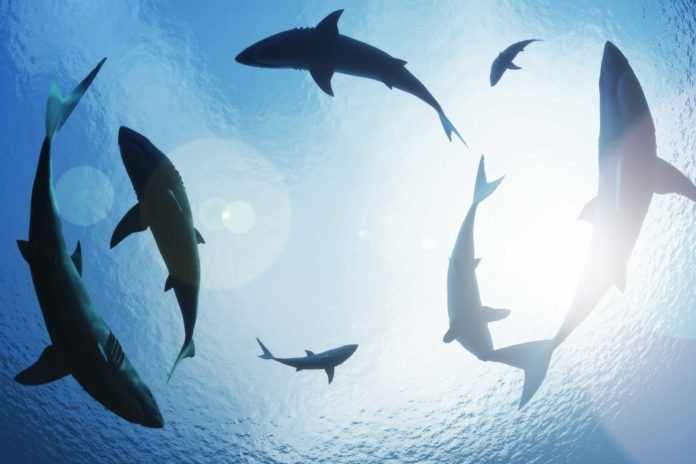Love them or loathe them, sharks are undoubtedly some of the most fascinating species on the planet. As divers, many of us spend a considerable amount of time and money travelling to shark diving destinations in search of our next encounter; while every year, millions of divers and non-divers gather around their television screens to watch Shark Week. Given our sharky obsession, we know surprisingly little about our finned friends.
As of September 2016, 191 shark species were listed as Data Deficient by the IUCN Red List. In 2015, six new shark species were described by science for the first time. Nevertheless, there are several shark facts that most people are familiar with, including that their skeletons are made from cartilage instead of bone, and that they can sense movements in the water through their lateral line. In this article, we take a look at some lesser known shark facts.
Perfectly Adapted Eyes
When it comes to senses, we usually focus on sharks’ acute hearing or their incredible sense of smell. However, shark eyes are also amazing, with certain species exhibiting several fascinating adaptations. Lamnid sharks (those belonging to the order Lamniformes, including great whites and makos) are capable of regulating their body temperature, including the heat of their brain and eyes. This allows them to see images in a higher resolution, and to more successfully detect prey movement.
Many sharks are nocturnal, and all of them live in low light conditions. In order to maximise their vision, all shark species have a tapetum lucidum, a layer of mirrored crystals located directly behind their retina. Instead of being absorbed and therefore wasted after entering the eye, light is reflected back to the retina a second time – allowing certain species to see up to 100 times better than humans in low light conditions.
Sharks are also able to contract and dilate their pupils, a unique trait amongst teleost fish species. Like humans, this allows them to regulate the amount of light entering their eye at any given time. Unlike humans, sharks also have the ability to switch between stereoscopic and monocular vision at will. This means that they can choose to see in 3D; or to use each eye independently to increase field of view and focus on two separate objects simultaneously.
Designed for Life in Salt Water
Osmosis dictates that water molecules move from areas with a high water concentration to areas with a low water concentration across a semi-permeable membrane. For most fish, this translates into a constant fight for equilibrium between the high water content of their tissues, and the high salt content of the ocean. They constantly lose water through their gills and skin, and have to drink large volumes of seawater to stop themselves from becoming dehydrated.
With several million years of evolution on their side, sharks have come up with a more sophisticated solution. They retain high quantities of a naturally salty metabolic waste called urea, so that their tissues are slightly more saline than the water around them. They do not lose water through osmosis, and neither do they have to drink. Instead, when the urea in their system needs to be diluted, they simply absorb more water through their mouth and gills.
If the shark’s water concentration becomes too high, they can excrete water from an opening between their pelvic fins. Generally, this adaptation means that sharks are incapable of tolerating freshwater. However, 43 shark and ray species (most famously including the bull shark) have developed a way to excrete large amounts of urea as needed, reducing the salt content of their tissues enough to bring them into balance with freshwater.
Fascinating Reproductive Methods
For some sharks, the processes of reproduction and gestation are utterly unique. For example, the sandtiger shark (also known as the ragged tooth or grey nurse shark) has twin uteruses. Each one harbours a clutch of fertilised embryos – until the first one hatches and spends the rest of its gestation snacking on its siblings. This phenomenon is known as intrauterine cannibalism, and helps ensure that the surviving pups (one from each uterus) are born strong.
Other species can retain sperm and use it to fertilise themselves long after mating. This is particularly common amongst pelagic sharks, who only meet members of the opposite sex very occasionally. Sometimes, if a female mates with several males before she decides to fertilise her eggs, the same litter can include pups from different fathers. The whale shark takes this a step further, by being able to use sperm from a single mating to fertilise eggs in batches.
Perhaps the most incredible adaptation of all is the ability of certain shark species to reproduce without mating at all. This phenomenon is known as parthenogenesis or virgin birth, and has been documented in several species including the oceanic blacktip, the bonnethead and the zebra shark. Parthenogenetic offspring have half of their mother’s DNA (which then copies itself to make up the rest of shark’s genetic material), and no male DNA. All offspring are therefore female.
Bonus Shark Fact:
On the surface, humans and sharks seem as about as dissimilar as it is possible to be. However, scientists believe that we have something in common – Acanthodes bronni, a prehistoric fish from the Paleozoic era thought to be the common ancestor of all jawed vertebrates. It was also the last common ancestor of cartilaginous fish (including sharks), and bony fish (a lineage that would one day evolve to include humans). The split between these two groups occurred approximately 420 million years ago.

